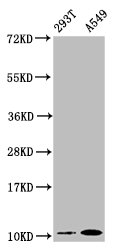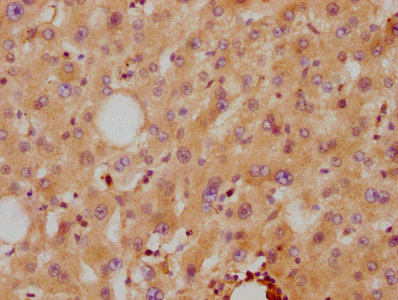APOA2 Recombinant Monoclonal Antibody
-
货号:CSB-RA001915A0HU
-
规格:¥1320
-
图片:
-
Western Blot
Positive WB detected in: 293T whole cell lysate, A549 whole cell lysate
All lanes: Apolipoprotein A II antibody at 0.87μg/ml
Secondary
Goat polyclonal to rabbit IgG at 1/50000 dilution
Predicted band size: 12 KDa
Observed band size: 12 KDa -
IHC image of CSB-RA001915A0HU diluted at 1:87.5 and staining in paraffin-embedded human liver tissue performed on a Leica BondTM system. After dewaxing and hydration, antigen retrieval was mediated by high pressure in a citrate buffer (pH 6.0). Section was blocked with 10% normal goat serum 30min at RT. Then primary antibody (1% BSA) was incubated at 4℃ overnight. The primary is detected by a biotinylated secondary antibody and visualized using an HRP conjugated SP system.
-
Overlay histogram showing A549 cells stained with CSB-RA001915A0HU (red line) at 1:50. The cells were fixed with 70% Ethylalcohol (18h) and then permeabilized with 0.3% Triton X-100 for 2 min. The cells were then incubated in 1x PBS /10% normal goat serum to block non-specific protein-protein interactions followed by primary antibody for 1 h at 4℃. The secondary antibody used was FITC goat anti-rabbit IgG (H+L) at 1/200 dilution for 1 h at 4℃. Control antibody (green line) was used under the same conditions. Acquisition of >10,000 events was performed.
-
-
其他:
产品详情
-
产品描述:
This is an APOA2 recombinant monoclonal antibody produced in vitro expression system. The clones constructed by the human APOA2 DNA gene and vector were transfected into the cell line for production. This APOA2 antibody is purified using affinity-chromatography. It is recommended for applications, including ELISA, WB, IHC, and FC.
APOA2 is a major constituent of high-density lipoprotein (HDL) mainly produced in the liver and small intestine. It appears to promote insulin secretion and play a role in protection against the development of the metabolic syndrome. Defects in the APOA2 gene may result in apolipoprotein A-II deficiency or hypercholesterolemia.
-
Uniprot No.:P02652
-
基因名:
-
别名:APO A2 antibody; Apo AII antibody; Apo-AII antibody; APOA 2 antibody; ApoA II antibody; ApoA-II antibody; APOA2 antibody; APOA2_HUMAN antibody; APOAII antibody; Apolipoprotein A II antibody; Apolipoprotein A-II(1-76) antibody; Apolipoprotein A2 antibody; Apolipoprotein AII antibody; ApolipoproteinA II antibody; OTTHUMP00000032244 antibody
-
反应种属:Human
-
免疫原:A synthesized peptide derived from human APOA2
-
免疫原种属:Homo sapiens (Human)
-
标记方式:Non-conjugated
-
克隆类型:Monoclonal
-
抗体亚型:Rabbit IgG
-
纯化方式:Affinity-chromatography
-
克隆号:6H2
-
浓度:It differs from different batches. Please contact us to confirm it.
-
保存缓冲液:Rabbit IgG in phosphate buffered saline , pH 7.4, 150mM NaCl, 0.02% sodium azide and 50% glycerol.
-
产品提供形式:Liquid
-
应用范围:ELISA, WB, IHC, FC
-
推荐稀释比:
Application Recommended Dilution WB 1:500-1:5000 IHC 1:50-1:200 -
Protocols:
-
储存条件:Upon receipt, store at -20°C or -80°C. Avoid repeated freeze.
-
货期:Basically, we can dispatch the products out in 1-3 working days after receiving your orders. Delivery time maybe differs from different purchasing way or location, please kindly consult your local distributors for specific delivery time.
相关产品
靶点详情
-
功能:May stabilize HDL (high density lipoprotein) structure by its association with lipids, and affect the HDL metabolism.
-
基因功能参考文献:
- Weight loss resulted from a reduction of HDL in both APOE-II genotypes. However, in C homozygote carriers, it was shown that HDL3 reduced significantly and leads to a general shift toward larger size HDL subfractions after intervention, while in T allele carriers HDL2 decreased significantly and weight loss leads to shift toward smaller size HDL subfractions. PMID: 28545455
- There was a statistically significant interaction between APOA2 polymorphism and dietary fatty acids intake on oxidative stress n patients with type 2 diabetes PMID: 27271094
- This study detected a reduced level of heterodimer apoA2-ATQ/AT and a specific apoA2 isoform hypo-processing pattern in the sera of autoimmune pancreatitis patients. PMID: 29481802
- In type 2 diabetes mellitus patients, the dietary intake of antiinflammatory fatty acids, such as omega-3 PUFAs and MUFAs, could reduce the inflammatory effects associated with the Apolipoprotein A2 CC genotype. In addition, proinflammatory fatty acids, such as SFAs, could overcome the antiinflammatory effect of the T-allele. PMID: 28359369
- data support an SR-B1 nibbling mechanism that is similar to that of streptococcal serum opacity factor, which also selectively removes CE and releases apoAI, leaving an apoAII-rich remnant. PMID: 28373285
- A new missense mutation in an Iranian population has a significant association with high-density lipoprotein cholesterol levels. PMID: 26590203
- ApoAII-ATQ/AT not only distinguished the early stages of pancreatic cancer from healthy controls but also identified patients at high risk for pancreatic malignancy. PMID: 26549697
- Plasma apoB pool size of VLDL containing apoA-II is much smaller than that of VLDL without apoA-II, and this was caused by a very low rate of secretion of this VLDL type into plasma. PMID: 26071654
- APOA-II polymorphism and oxidative stress is associated with poor prognosis in patients with type 2 diabetes. PMID: 26104730
- Apolipoprotein AII was detected as a protein associated with the urinary protein/urinary creatinine levels in pediatric idiopathic steroid-sensitive nephrotic syndrome PMID: 24633472
- Apolipoprotein A-II/B significantly improves risk prediction of overall survival, also in carotid surgery patients with lower LDL levels PMID: 25953375
- Apolipoprotein A-II and the regulation of high density lipoproteins in cardiovascular disease. [Review] PMID: 24012775
- We have cloned the cDNA encoding human ApoA-II and achieved its high-level secreting expression with a yield of 65 mg/L of yeast culture PMID: 24116940
- identified a statistically significant interaction between the APOA2 -265T > C variant and higher-fat dairy food intake in the Boston Puerto Ricans and replicated this relation in the GOLDN study PMID: 24108135
- Clinical studies demonstrate that apoA-II is a strong predictor of risk for CVD. There is no evidence, however, that selective therapeutic modification of apoA-II impacts on atherosclerosis and clinical outcomes.[review] PMID: 21501035
- These data suggest Apo-AII-containing high-density lipoproteins (HDL) formed intrahepatically are likely cholesterol-rich compared to the smaller intracellular lipid-poor Apo A-I HDL. PMID: 23025327
- Enrichment of apo A-II in high-density lipoprotein particles has atheroprotective effects and apo A-II may become a target for the treatment of atherosclerosis. PMID: 23241412
- We conclude that apoA-II plays a significant role in apoE-associated risk of incident CVD in women with high levels of HDL-C and CRP. PMID: 22723940
- APOA2 m265 genotype may be associated with eating behaviours and dietary modulation of plasma ghrelin. PMID: 21386805
- a gene-diet interaction involving the APOA2 -265T>C SNP and saturated fat intake determines body weight in a Mediterranean and an Asian populations PMID: 20975728
- Human apolipoprotein A-II inhibits the production of interferon-gamma by concanavalin A-stimulated mouse and human CD4-positive T cells. PMID: 21300819
- Low apolipoprotein-A2 is associated with metastatic renal cell cancer. PMID: 20022911
- ApoA-II plays a crucial role in triglyceride catabolism by regulating lipoprotein lipase activity, at least in part, through HDL proteome modulation. PMID: 19910634
- The serum apoA-II concentrations confer risk for MetS and diabetes and exhibit evidence of anti-inflammatory properties among Turks. PMID: 19817643
- In metabolic syndrome, fenofibrate, but not atorvastatin, influences high density lipoprotein metabolism by increasing the transport of APOA2 particles. PMID: 19651918
- when expressed in transgenic mice, HDL shows antioxidant properties PMID: 11971944
- Overexpression in transgenic mice does not increase their susceptibility to insulin resistance and obesity PMID: 12032642
- Evaluated as a positional candidate gene for familial Type II diabetes, altered lipid concentrations, and insulin resistance PMID: 12136402
- Crystallographic studies of apo A-II and its complex with lipid surrogate beta-octyl glucoside show that disulfide-linked dimers of apo A-II form amphipathic alpha-helices which aggregate into tetramers. PMID: 12269810
- Carriers of a novel splice-site mutation in the LDL-receptor gene were simultaneously homozygous for the -265C variant of apoA-II thus concluding that one variant of the apoA-II gene was associated with reduced plasma LDL cholesterol in FH patients PMID: 12522687
- This protein inhibits high density lipoprotein remodeling and lipid-poor apolipoprotein A-I formation PMID: 12690114
- Genetic association of plasma apolipoprotein A-II levels with familial combined hyperlipidemia. PMID: 12738753
- Analysis of trancription factors that bind response elements in the apoA-II promotor and modulate transcription. PMID: 12959642
- apoA-II affects both the structure and the dynamic behavior of HDL particles and selectively modifies lipid metabolism PMID: 14967812
- In transgenic mice overexpressing the human apoA-II gene, plasma human apoA-II concentration was positively correlated with blood glucose levels. PMID: 14988251
- this protein-exonic splicing enhancer interaction is able to promote the incorporation of exon 3 in mRNA and suggest that they can rescue the splicing despite the noncanonical 3' splice site. PMID: 15247216
- Overexpressed human apoA-II in mice impairs HDL protection of apoB-lipoproteins from oxidation. Displacement of PON1 by apoA-II may explain why PON1 is found in HDL particles with apoA-I, not apoA-II, & apo-A-II-rich HDL's poor antiatherogenic properties. PMID: 15388641
- results indicate a significant association between the T265C APOA-II polymorphism and levels of visceral adipose tissue in premenopausal women present in white but not African-American women PMID: 15833935
- Characterization of regulatory elements found in the apoA-II exon 3 and its flanking introns that are involved in the control of apoA-II exon 3 splicing. PMID: 16254078
- the association of apoA-II with triglyceride-rich lipoproteins occurs in the circulation and induces postprandial hypertriglyceridemia PMID: 16990646
- ApoA-II adopts a beltlike structure in which the protein helices wrap around the lipid- bilayer reconstituted high density lipoprotein (rHDL) disc. PMID: 17264082
- ApoAII is efficiently reabsorbed in kidney proximal tubules in relation to its plasma concentration PMID: 17652309
- carriers of the minor allele for Apo A-II -265T/C (CC/TC) have a lower postprandial response compared with TT homozygotes PMID: 17709437
- ApoA-II is associated with a decreased risk of future coronary artery disease in apparently healthy people, implying that apoA-II itself exerts effects on specific antiatherogenic pathways. PMID: 17923573
- APOAII rs5082 polymorphism may have a role in reducing risk of coronary artery disease in an Australian male population PMID: 18179799
- results for dimeric apolipoprotein AII are similar to those we have reported for the monomeric apolipoprotein CI, which has a similar secondary structure but a different peptide sequence and net charge PMID: 18652418
- procoagulant activities of plasma factor VIIc and factor Xc are positively and independently associated with concentrations of the high-density lipoprotein apolipoprotein, apo A-II PMID: 18766253
- small sizes (i. e., number of kringle-4 repeats in the gene) of apolipoprotein (a) are risk factors for the development of atherothrombosis. (review) PMID: 19069164
- Results indicate that CETP inhibition increases plasma concentrations of apoA-II by delaying HDL apoA-II catabolism and significantly alters the remodeling of apoA-II-containing HDL subpopulations. PMID: 19193611
- The available data does not support a role for common variants in APOA2 on type 2 diabetes susceptibility or related quantitative traits in Northern Europeans PMID: 19216768
显示更多
收起更多
-
亚细胞定位:Secreted.
-
蛋白家族:Apolipoprotein A2 family
-
组织特异性:Plasma; synthesized in the liver and intestine.
-
数据库链接:
HGNC: 601
OMIM: 107670
KEGG: hsa:336
STRING: 9606.ENSP00000356969
UniGene: Hs.237658
Most popular with customers
-
-
YWHAB Recombinant Monoclonal Antibody
Applications: ELISA, WB, IF, FC
Species Reactivity: Human, Mouse, Rat
-
Phospho-YAP1 (S127) Recombinant Monoclonal Antibody
Applications: ELISA, WB, IHC
Species Reactivity: Human
-
-
-
-
-























